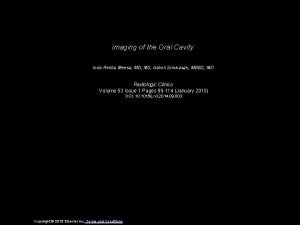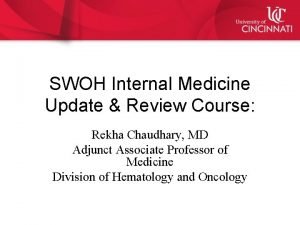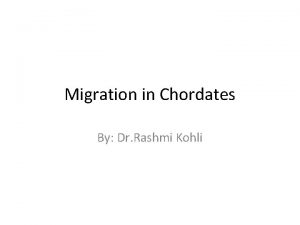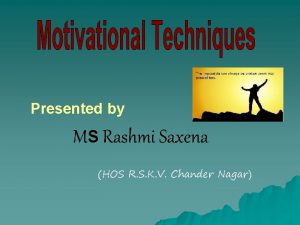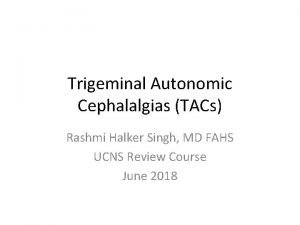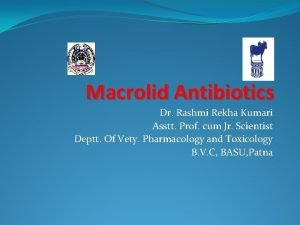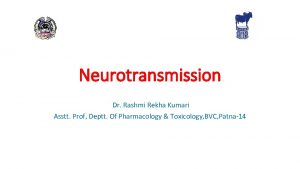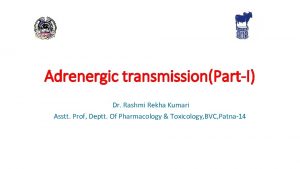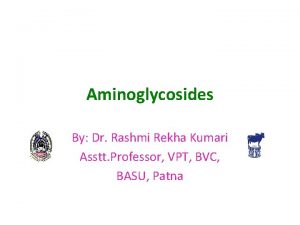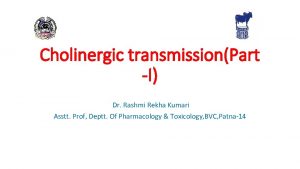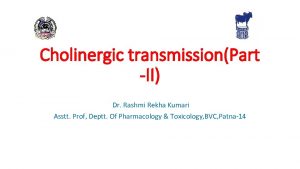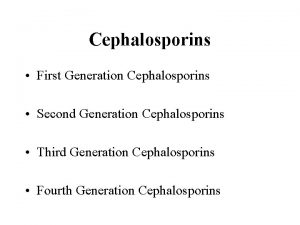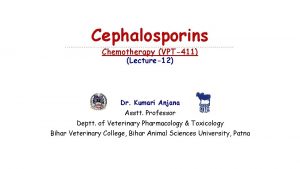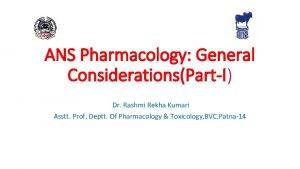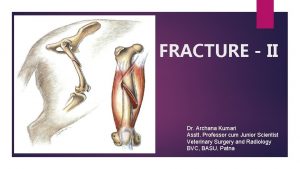Cephalosporins Dr Rashmi Rekha Kumari Asstt Prof cum













- Slides: 13

Cephalosporins Dr. Rashmi Rekha Kumari Asstt. Prof. cum Jr. Scientist Deptt. Of Vety. Pharmacology and Toxicology B. V. C, BASU, Patna

• In 1945, Cephalosporium acremonium was isolated from raw sewage from the sea in sardinia. • The first cephalosporin, cephalosporin C was derived from this fungus. • All other cephalosporins are semisynthetic antibiotics derived from cephalosporin C

• The Cephalosporin molecule contain a 7 amino cephalosporanic acid consisting of • A beta-lactam ring like penicillins and • A dihydrothiazine unlike penicillins

Chemistry of Cephalosporins Dihydrothiazine Rng Beta lactam Ring 7 -Aminocephalosporanic Acid

• Unlike the 6 -aminopenicillillanic acid of penicillins, the 7 aminocephalosporanic acid molecule in cephalosporins provides more sites (R 1 and R 2) for chemical manipulation in the production of many semisynthetic cephalosporins. • Addition of various group at the R position forms derivatives with differences in their antimicrobial activity, stability against beta lactamase, protein binding, intestinal absorption, metabolism and toxicity.


• Classification: Based on when synthesised • First Generation: Oral : Cephalexin, cephradine , cefadroxil, cephalogylcin, Parenteral: Cefapirin, cefazolin, cephalothin, Cephalonia. Intramammary: Cefacetrile, cefapirin, cephalonium. • Second Generation: Oral: Cefachlor, cefuroxime axetil Parenteral : Cefamandole, cefonicid, ceforonide, cefotoxifin, cefuroxime. • Intramammary: Cefuroxime • Third Generation : Oral : Cefixime, cefpodoxime proxetil, cefdinir, ceftibuten • Parenteral: Cefmenoxine, ceftiofur, cefoperazone, cefotaxime, cefsulodin, ceftazidime, ceftizoxime, ceftriaxone • Fourth Generation: Parenteral: cefepime and Cefpirome.

Spectrum of Activity • First Generation: • Cephalosporins have high activity against Gram positive, effective againt all gram positive bacteria except enterococcus. • Also effective against beta lactamase producing staphylococcus. • They also have greater activity against members of enterobacteriaceae, than penicillin G. • Relatively susceptible to cephalosporinase and are not effective against pseudomonas aeruginosa

Second Generation • These drugs have greater activity against many gram negative bacteria that are resistant to first generation drugs(e. g. , resistant E. coli. Klebsiella, Proteus, Enterobactor) • Relatively resistant to beta-lactamase from gram –ve bacteria • Cefoxitin and cefotetan belong to the cephamycin group and are often used clinically because of good activity against anaerobic bacteria(Bacteroides fragilis)

Third Generation • Have more activity against gram negative bacteria than earlier generation of cephalosporins • All are highly resisant to betalactamase from gram negative bacteria. • Only Ceftazidime and Cefoperazone have good activity against Pseudomonas aeruginosa • Less active against gran+ve cocci. • Ceftiofur has been used extensively in veterinary medicine especially in cattle and is also registered for use in horse and dog. • A new addition to the Vety. Drug is cefovecin which is an injectable formulation that has an extremely long life compared to other cephalosporins.

Fourth Generation • Example: Cefepime and Cefpirome • More potent than third generation cephalosporins • Have spectrum of activity similar to third generation but more potent than it, active against gram +ve cocci, gram –ve bacilli and Pseudomonas aeruginosa • Active against beta lactamase producing strains of bacteria resistant to other beta lactam antibiotics • Indicated for serious, hospital acquired infection including septicaemia, lower respiratory tract infection.


• Thank You



